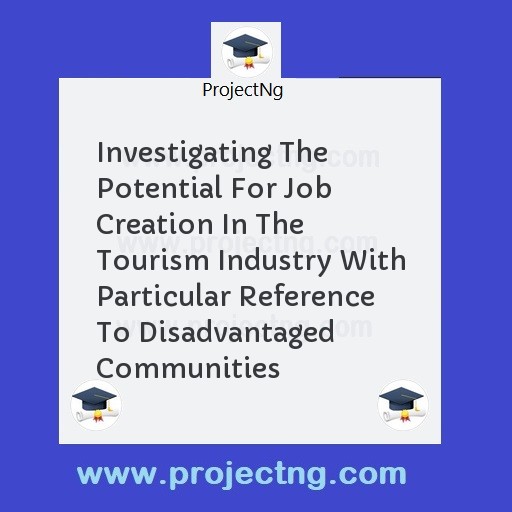Investigating The Potential For Job Creation In The Tourism Industry With Particular Reference To Disadvantaged Communities
Political Science Project Topics
Get the Complete Project Materials Now! »
Investigating the Potential for Job Creation in the Tourism Industry with particular reference to Disadvantaged
Communities
ABSTRACT
This paper explores the potential for tourism to impact positively on job creation especially its capacity to stimulate other sectors of the economy. This paper uses South African and international experience to demonstrate how people especially from the disadvantaged communities can participate and benefit in the tourism industry.
Further, it outlines a number of factors to be considered in order to enhance tourism development. These factors include: funding, expanding infrastructure, education and training, taxing the industry intelligently, private and public partnership, ownership of the land and natural resources, marketing strategies and transformation in the tourism industry.
Lastly, this paper outlines some negative aspects in the South African context, which dampen the success of tourism industry.
TABLE OF CONTENTS page
1. Introduction 3
2. Tourism potential for job creation 5
2.1 Tourism Size and Performance in South Africa 5
2.2 Employment in the Tourism Industry 6
2.3 The Capacity of the Tourism Industry to Create Jobs in South Africa 8
2.3.1 Cultural Tourism 10
2.3.2 Township cuisine 11
2.3.3 Eco-tourism 12
2.3.4 Other Business Opportunities 13
2.4 Tourism Stimulates other Sectors of the Economy 16
3. Developing South Africa’s tourism potential 17
3.1 Expanding Infrastructure 17
3.2 Intelligent Taxing 18
3.3 Education and Training 19
3.4 Partnerships in Tourism 20
3.5 Ownership of Land and Natural Resources 21
3.6 Funding 22
3.7 Marketing 23
3.8 Transformation in the Tourism Industry 24
4. The Socio-Economic Impact on Tourism 25
4.1 Crime 25
4.2 Diseases and Other Problems 26
5. Concluding remarks 28
6. Bibliography 30
1. INTRODUCTION
The low level of economic growth and the rigid labor market structure in South Africa makes it difficult for the formal economy to absorb the new labor force entering the market. This rapidly increases the level of unemployment. In 1997, unemployment was estimated at 38%. With the South African labor force growing at approximately 2 –2.5 % a year, this means that 300 000 people are coming into the labor market each year (Orkin 1999). According to Pape (1999), employment in South Africa since 1994 has dropped form 40 000 down to approximately 22 000 in the textile industry alone. Unemployment is the principal social and economic challenge facing South Africa so it is apparent that employment creation is very important in South Africa.
The manufacturing industry in South Africa is still restructuring in order to face international competition. It was protected from international competition since the early sixties and became less efficient. Now due to trade liberalization adopted in the past few years, it is unlikely that there would be a rise in its potential to contribute to employment creation. Pape (1999) estimates that within 10 years, manufacturing employment will not be significantly increased in South Africa. A low level of fiscal deficit coupled with the 3% target rule (and the overshooting of this in the past two years) also suggests that the government does not have the capacity or the will to become a major driving force for job creation.
The high cost associated with in particular deep level mining also makes it difficult for this industry to lead employment creation. Visser (1999, 2) confirms that both primary and secondary sectors are no longer reliable in leading employment and economic growth due to “the roller-coaster fluctuation in commodity prices shackling the global economy today. Instead, a more mobile, educated and nature deprived population suggests far stronger guarantees for growth in tourism particularly Eco- and cultural tourism”. Perhaps service industries can provide a strong alternative in driving employment creation.
Despite the promise that the service industry holds, we need to be cautious because the service industry covers a wide variety of jobs. Palma (1999) makes an important distinction between two types of services and their role in employment contribution. One is production related services (i.e. finance, transport, technical education which support production) and these are declining, while freestanding services (i.e. basic education, tourism, government services, personal services) are growing and so also the possibility of their contribution to increasing employment. In South Africa, we can no longer expect manufacturing to be the major driver of job creation. The challenge facing policy makers now is to focus on keeping existing jobs while creating additional employment opportunities.
The 1994 democratic election which heralded the Mandela presidency, brought about a profound change as it ended the apartheid policy system of governance and with that the political unrest and sanction against South Africa. This paved the way for tourism as an alternative form of employment creation. Now tourism could be accepted as one of the key drivers for job growth, wealth creation and economic empowerment. Tourism is internationally accepted as one of the world’s fastest growing industries and South Africa on the other hand has emerged as a highly attractive destination because it has both depth and diversity of tourism products.
Peter Hawthorne (1999) confirms that the dramatic changes of 1990 took South Africa out of political and economic isolation. This succeeded in putting the country on the international travel and tourism map. He points out that in 1994, the number of regional and overseas holiday visitors increased by 50% to more than 5 million a year. Since tourism is the world’s fastest growing industry, the objective of this study is to look at tourism as an alternative for job creation in South Africa.
Be the First to Share On Social















